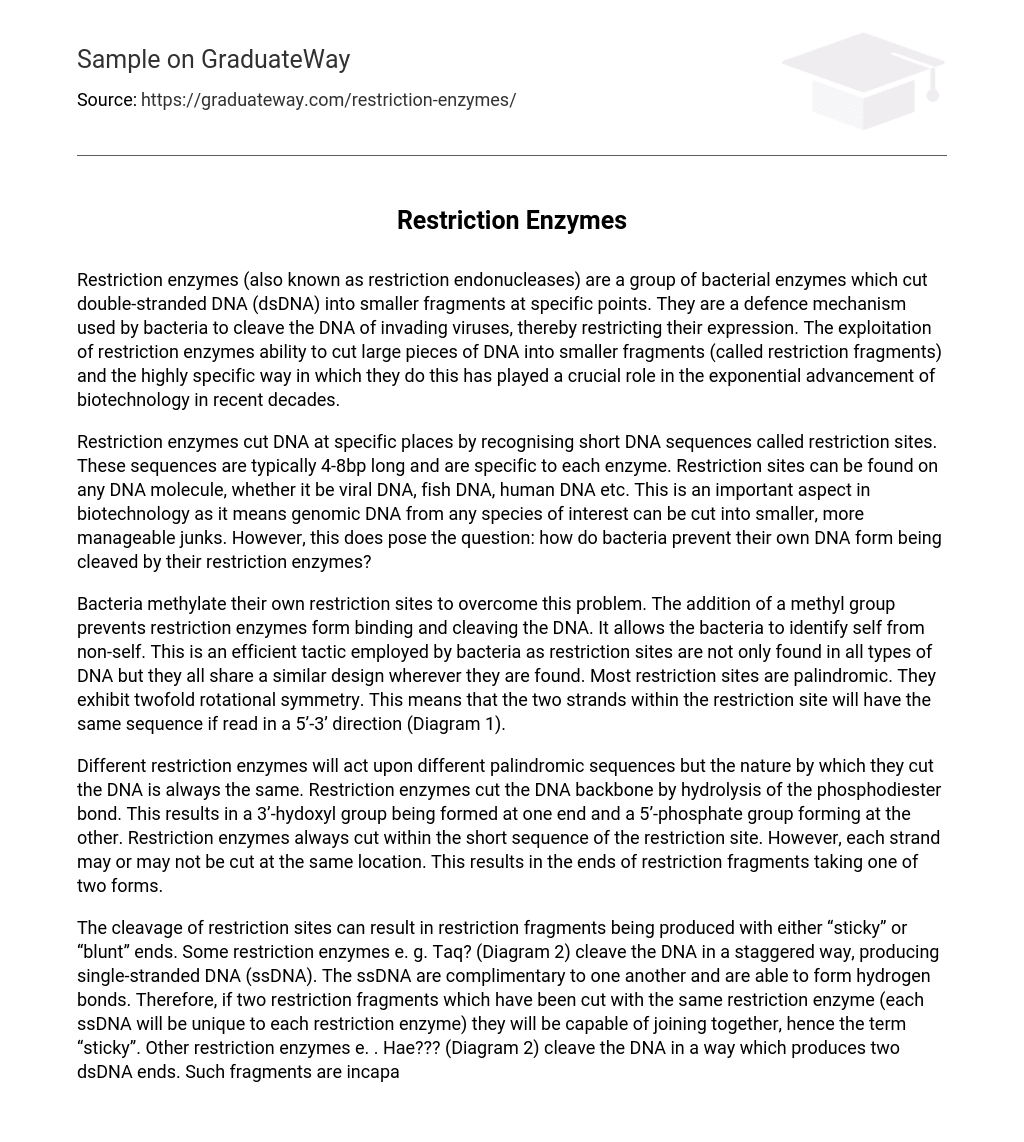Restriction enzymes (also known as restriction endonucleases) are a group of bacterial enzymes that cleave double-stranded DNA (dsDNA) at specific points, resulting in smaller fragments. These enzymes are used by bacteria as a defense mechanism against invading viruses, limiting their expression. The precise and efficient ability of restriction enzymes to cut large DNA pieces into smaller fragments, known as restriction fragments, has been pivotal in the rapid progress of biotechnology in recent years.
Restriction enzymes are enzymes that cut DNA at specific locations by identifying short DNA sequences known as restriction sites. These restriction sites are typically 4-8bp in length and are unique to each enzyme. They can be found on various DNA molecules, ranging from viral DNA to fish DNA and even human DNA. This characteristic plays a significant role in biotechnology because it allows for the fragmentation of genomic DNA from any desired species into smaller, more easily manageable fragments. Nevertheless, this raises a question: how do bacteria protect their own DNA from being cleaved by their own restriction enzymes?
To overcome the problem of restriction enzymes binding and cleaving the DNA, bacteria use their own mechanism of methylating their restriction sites. By adding a methyl group, the bacteria prevent the restriction enzymes from binding and cleaving the DNA. This allows the bacteria to distinguish between self and non-self DNA. This tactic is effective because restriction sites are universally present in all types of DNA and share a similar design. Most restriction sites are palindromic in nature and exhibit twofold rotational symmetry. In other words, the sequence of the two strands within the restriction site remains the same when read in a 5’-3’ direction (see Diagram 1).
Various restriction enzymes recognize different palindromic sequences and utilize the same mechanism for cutting DNA. By hydrolyzing the phosphodiester bond, restriction enzymes cleave the DNA backbone, generating a 3’-hydroxyl group and a 5’-phosphate group. Although restriction enzymes consistently cut within the limited sequence of the restriction site, the exact location of cleavage may vary between strands. Consequently, the resulting ends of restriction fragments can assume two distinct configurations.
The cleavage of restriction sites can lead to the production of restriction fragments with either sticky or blunt ends. Certain restriction enzymes, like Taq? (Diagram 2), cleave the DNA in a staggered manner, resulting in single-stranded DNA (ssDNA). The ssDNA are complementary to each other and can form hydrogen bonds. Hence, when two restriction fragments that have been cut with the same restriction enzyme (each ssDNA will be unique to each restriction enzyme) are joined together, they are referred to as “sticky”. Other restriction enzymes, such as Hae??? (Diagram 2), cleave the DNA to produce two double-stranded DNA (dsDNA) ends. These fragments cannot form hydrogen bonds with each other and are therefore called “blunt”. Sticky-ended restriction enzymes are particularly useful because they can be used with DNA ligase to connect specific pieces of DNA from different sources, creating recombinant DNA. When two pieces of DNA are cut with the same restriction enzyme, they will form complementary strands that can bond with each other through a process called hybridization (Diagram 3).
The outcome of hybridisation is the creation of a new “recombinant” segment of DNA, featuring a continuous sequence of dsDNA bound together. Nevertheless, even though the base-pairs have formed hydrogen bonds, the sugar-phosphate backbone of the recombinant DNA remains unconnected. DNA ligase can be introduced for this purpose. DNA ligase establishes covalent bonds along the sugar-phosphate backbone of the recombinant DNA, effectively fusing it (Diagram 3). By combining the action of restriction enzymes and DNA ligase, two distinct DNA fragments can be joined together to produce recombinant DNA (Diagram 3).
Blunt ends have the potential to create recombinant DNA with just DNA ligase, but it is a slow process. Modifying blunt ends can enhance efficiency and enable them to efficiently create recombinant DNA. There are multiple methods for achieving this. For example, in PCR, specialized primers with a restriction site can generate blunt ends as a product. When treated with the proper restriction enzyme, sticky ends can be generated.
Alternatively, oligonucleotides containing restriction sites can be ligated to blunt ends. If treated with restriction enzymes, sticky ends can be generated (Diagram 5). It is crucial to confirm that the original DNA sequence does not possess the same restriction site as the added DNA because it will result in the cleavage of the desired DNA sequence by the restriction enzyme. In such instances, alternative restriction sites can be introduced.
The combination of restriction enzymes and DNA ligase enables the production of recombinant DNA, whether through sticky or blunt ends. This process holds immense significance in modern genetic analysis. In the past, the large size of genomic DNA made genetic analysis incredibly challenging. However, the use of restriction enzymes to divide large portions of DNA into smaller, more manageable sizes marked a crucial initial step. This breakthrough allowed for substantial progress in gene analysis and the study of gene expression.
The initial phase of the human genome project involved fragmenting the human genome using restriction enzymes. Different labs around the world then sequenced these smaller pieces and reassembled them. This process, along with the development of other techniques like cloning and probing, is what forms the foundation of modern recombinant technology. As a result, biology has shifted from being primarily theoretical to being more focused on practical application.





